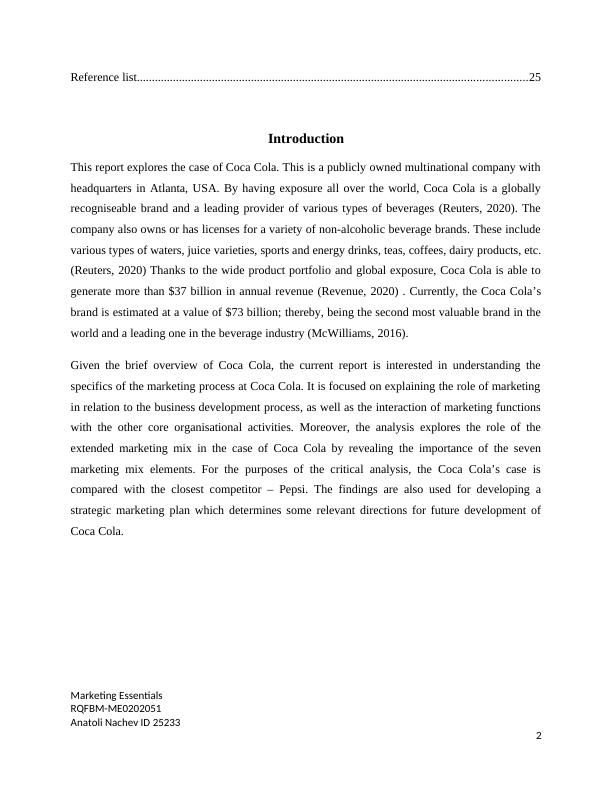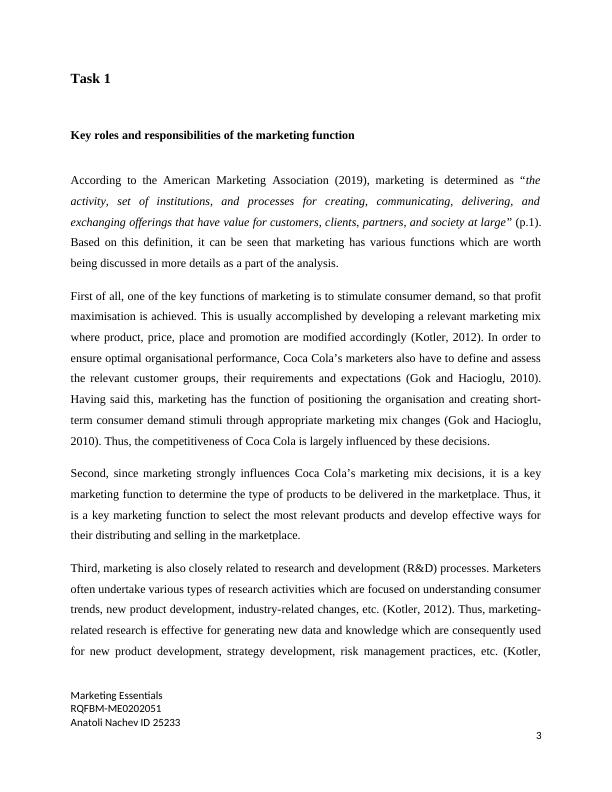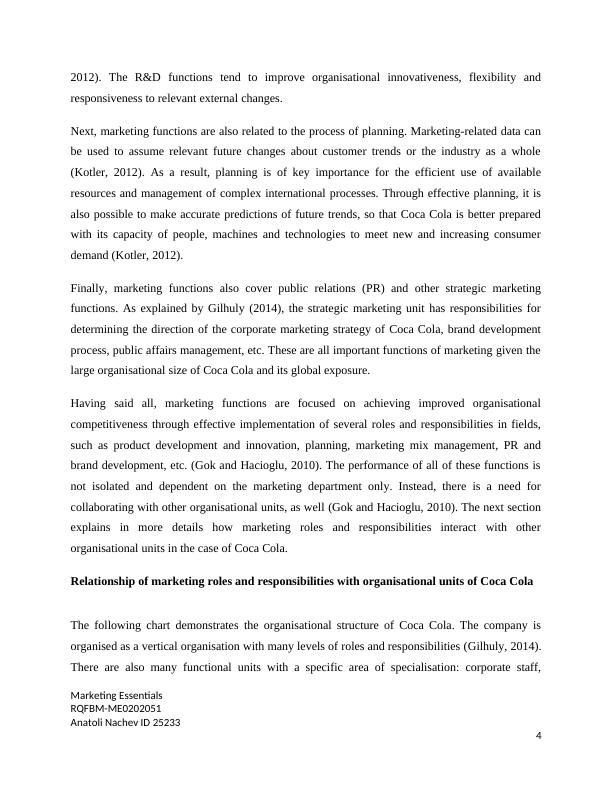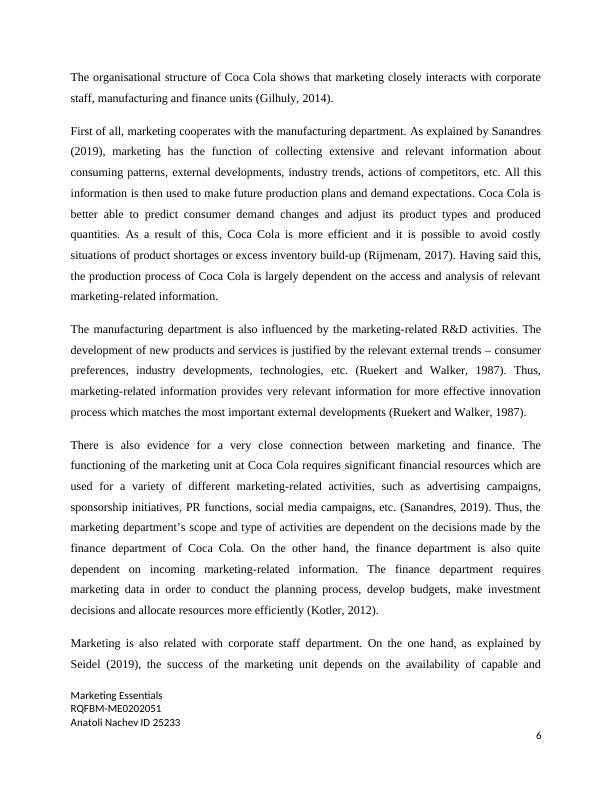Analyse and Evaluate the Key Elements of Marketing Function
27 Pages6769 Words121 Views
Added on 2021-07-09
Analyse and Evaluate the Key Elements of Marketing Function
Added on 2021-07-09
ShareRelated Documents
Table of ContentsIntroduction.......................................................................................................................................3Task 1:Critically analyse and evaluate the key elements of marketing function and the importance of interrelationships between marketing and other functional units of your chosen organisation.......................................................................................................................................3Key roles and responsibilities of the marketing function.............................................................3Relationship of marketing roles and responsibilities with organisational units of Coca Cola.....5Task 2Critically evaluate roles and responsibilities of the marketing function in the context of themarketing environment of your chosen organisation......................................................8PESTEL – macro environment.....................................................................................................8SWOT analysis – internal analysis.............................................................................................10Task 3:Design a coherent evidenced-based strategic marketing plan and tactically evaluate how the 7Ps have been applied to achieve overall business objectives of your chosen organisation in comparison to a selected competitor in the same industry.............................................11Marketing mix analysis.............................................................................................................11Basic marketing plan.................................................................................................................18Objectives................................................................................................................................19SWOT analysis........................................................................................................................20Segmentation and targeting.....................................................................................................21Marketing mix decisions.........................................................................................................23Implementation, evaluation and control..................................................................................23Conclusion......................................................................................................................................25Marketing Essentials RQFBM-ME0202051Anatoli Nachev ID 252331

Reference list..................................................................................................................................25IntroductionThis report explores the case of Coca Cola. This is a publicly owned multinational company withheadquarters in Atlanta, USA. By having exposure all over the world, Coca Cola is a globallyrecogniseable brand and a leading provider of various types of beverages (Reuters, 2020). Thecompany also owns or has licenses for a variety of non-alcoholic beverage brands. These includevarious types of waters, juice varieties, sports and energy drinks, teas, coffees, dairy products, etc.(Reuters, 2020) Thanks to the wide product portfolio and global exposure, Coca Cola is able togenerate more than $37 billion in annual revenue (Revenue, 2020) . Currently, the Coca Cola’sbrand is estimated at a value of $73 billion; thereby, being the second most valuable brand in theworld and a leading one in the beverage industry (McWilliams, 2016).Given the brief overview of Coca Cola, the current report is interested in understanding thespecifics of the marketing process at Coca Cola. It is focused on explaining the role of marketingin relation to the business development process, as well as the interaction of marketing functionswith the other core organisational activities. Moreover, the analysis explores the role of theextended marketing mix in the case of Coca Cola by revealing the importance of the sevenmarketing mix elements. For the purposes of the critical analysis, the Coca Cola’s case iscompared with the closest competitor – Pepsi. The findings are also used for developing astrategic marketing plan which determines some relevant directions for future development ofCoca Cola. Marketing Essentials RQFBM-ME0202051Anatoli Nachev ID 252332

Task 1Key roles and responsibilities of the marketing functionAccording to the American Marketing Association (2019), marketing is determined as “theactivity, set of institutions, and processes for creating, communicating, delivering, andexchanging offerings that have value for customers, clients, partners, and society at large” (p.1).Based on this definition, it can be seen that marketing has various functions which are worthbeing discussed in more details as a part of the analysis. First of all, one of the key functions of marketing is to stimulate consumer demand, so that profitmaximisation is achieved. This is usually accomplished by developing a relevant marketing mixwhere product, price, place and promotion are modified accordingly (Kotler, 2012). In order toensure optimal organisational performance, Coca Cola’s marketers also have to define and assessthe relevant customer groups, their requirements and expectations (Gok and Hacioglu, 2010).Having said this, marketing has the function of positioning the organisation and creating short-term consumer demand stimuli through appropriate marketing mix changes (Gok and Hacioglu,2010). Thus, the competitiveness of Coca Cola is largely influenced by these decisions. Second, since marketing strongly influences Coca Cola’s marketing mix decisions, it is a keymarketing function to determine the type of products to be delivered in the marketplace. Thus, itis a key marketing function to select the most relevant products and develop effective ways fortheir distributing and selling in the marketplace. Third, marketing is also closely related to research and development (R&D) processes. Marketersoften undertake various types of research activities which are focused on understanding consumertrends, new product development, industry-related changes, etc. (Kotler, 2012). Thus, marketing-related research is effective for generating new data and knowledge which are consequently usedfor new product development, strategy development, risk management practices, etc. (Kotler,Marketing Essentials RQFBM-ME0202051Anatoli Nachev ID 252333

2012). The R&D functions tend to improve organisational innovativeness, flexibility andresponsiveness to relevant external changes. Next, marketing functions are also related to the process of planning. Marketing-related data canbe used to assume relevant future changes about customer trends or the industry as a whole(Kotler, 2012). As a result, planning is of key importance for the efficient use of availableresources and management of complex international processes. Through effective planning, it isalso possible to make accurate predictions of future trends, so that Coca Cola is better preparedwith its capacity of people, machines and technologies to meet new and increasing consumerdemand (Kotler, 2012). Finally, marketing functions also cover public relations (PR) and other strategic marketingfunctions. As explained by Gilhuly (2014), the strategic marketing unit has responsibilities fordetermining the direction of the corporate marketing strategy of Coca Cola, brand developmentprocess, public affairs management, etc. These are all important functions of marketing given thelarge organisational size of Coca Cola and its global exposure. Having said all, marketing functions are focused on achieving improved organisationalcompetitiveness through effective implementation of several roles and responsibilities in fields,such as product development and innovation, planning, marketing mix management, PR andbrand development, etc. (Gok and Hacioglu, 2010). The performance of all of these functions isnot isolated and dependent on the marketing department only. Instead, there is a need forcollaborating with other organisational units, as well (Gok and Hacioglu, 2010). The next sectionexplains in more details how marketing roles and responsibilities interact with otherorganisational units in the case of Coca Cola. Relationship of marketing roles and responsibilities with organisational units of Coca Cola The following chart demonstrates the organisational structure of Coca Cola. The company isorganised as a vertical organisation with many levels of roles and responsibilities (Gilhuly, 2014).There are also many functional units with a specific area of specialisation: corporate staff,Marketing Essentials RQFBM-ME0202051Anatoli Nachev ID 252334

manufacturing, marketing and finance. Given the fact that Coca Cola is a large internationalcompany, there are also geographically determined units, which are responsible for a givencontinent, as shown at the chart (Gilhuly, 2014).Figure 1 – Coca Cola’s organisational structureSource: Gilhuly (2014)The organisational chart of Coca Cola clearly demonstrates the importance of the marketingdepartment. The latter is positioned at one of the highest organisational levels in the hierarchyand its actions largely determine the performance of all of the above-mentioned organisationalunits (Gilhuly, 2014). Moreover, as already suggested by Gok and Hacioglu (2010), marketingroles and responsibilities are performed by cooperating with other organisational departments.Marketing Essentials RQFBM-ME0202051Anatoli Nachev ID 252335

The organisational structure of Coca Cola shows that marketing closely interacts with corporatestaff, manufacturing and finance units (Gilhuly, 2014).First of all, marketing cooperates with the manufacturing department. As explained by Sanandres(2019), marketing has the function of collecting extensive and relevant information aboutconsuming patterns, external developments, industry trends, actions of competitors, etc. All thisinformation is then used to make future production plans and demand expectations. Coca Cola isbetter able to predict consumer demand changes and adjust its product types and producedquantities. As a result of this, Coca Cola is more efficient and it is possible to avoid costlysituations of product shortages or excess inventory build-up (Rijmenam, 2017). Having said this,the production process of Coca Cola is largely dependent on the access and analysis of relevantmarketing-related information. The manufacturing department is also influenced by the marketing-related R&D activities. Thedevelopment of new products and services is justified by the relevant external trends – consumerpreferences, industry developments, technologies, etc. (Ruekert and Walker, 1987). Thus,marketing-related information provides very relevant information for more effective innovationprocess which matches the most important external developments (Ruekert and Walker, 1987).There is also evidence for a very close connection between marketing and finance. Thefunctioning of the marketing unit at Coca Cola requires significant financial resources which areused for a variety of different marketing-related activities, such as advertising campaigns,sponsorship initiatives, PR functions, social media campaigns, etc. (Sanandres, 2019). Thus, themarketing department’s scope and type of activities are dependent on the decisions made by thefinance department of Coca Cola. On the other hand, the finance department is also quitedependent on incoming marketing-related information. The finance department requiresmarketing data in order to conduct the planning process, develop budgets, make investmentdecisions and allocate resources more efficiently (Kotler, 2012). Marketing is also related with corporate staff department. On the one hand, as explained bySeidel (2019), the success of the marketing unit depends on the availability of capable andMarketing Essentials RQFBM-ME0202051Anatoli Nachev ID 252336

End of preview
Want to access all the pages? Upload your documents or become a member.
Related Documents
Roles and Responsibilities of Marketing Function in Coca Colalg...
|16
|4601
|62
Roles and Responsibilities of Marketing Functionslg...
|22
|6744
|60
Roles and Responsibilities of marketing which are related to wider organisational contextlg...
|21
|6738
|76
Roles and responsibility of marketing in Coca-Colalg...
|13
|3550
|498
Marketing and Communication in Digital Worldlg...
|22
|2746
|56
Hospitality Marketing Essentials - Assignment Solvedlg...
|12
|2906
|19
